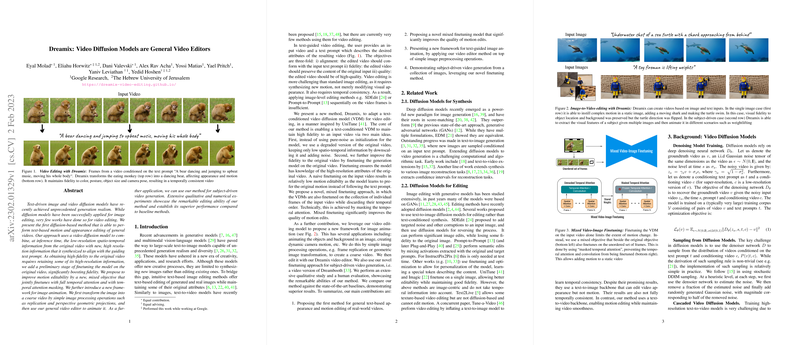Dreamix: Video Diffusion Models as Comprehensive Video Editors
The paper "Dreamix: Video Diffusion Models are General Video Editors" introduces a novel methodology for utilizing video diffusion models (VDMs) to perform extensive text-based editing for videos. While the evolution of diffusion models has enriched the field of image generation with unprecedented realism and diversity, their application to video editing remains limited. This paper presents Dreamix, the first framework to leverage VDMs as comprehensive video editors, capable of integrating text prompts to edit both the appearance and motion of general videos.
Overview
Dreamix operates by leveraging VDMs to synthesize high-resolution details consistent with both the original video and the guiding text prompt. The methodology involves two pivotal stages: initialization and fine-tuning. Initially, the original video is transformed by combining original low-resolution spatio-temporal components with synthetically generated high-resolution details, ensuring alignment with text prompts. For achieving high fidelity to the original video, the model undergoes fine-tuning using the specific video content.
The fine-tuning paradigm proposed in this paper is particularly noteworthy. By applying a mixed finetuning approach—integrating both full temporal attention and temporal attention masking—the method enhances the editability of motion cues within the video. Besides video editing, Dreamix presents a framework for image animation, employing basic image processing to transform static images into videos, which are then refined using the VDM, enabling not only object synthesis but also dynamic camera motions.
Methodology and Results
Dreamix is evaluated through extensive qualitative experiments alongside numerical analyses, demonstrating superior performance in comparison to baseline techniques. The paper outlines Dreamix’s core contributions:
- Pioneering a video diffusion-based approach for comprehensive text-based video editing.
- Innovating a robust mixed finetuning methodology enhancing motion edit quality.
- Introducing a systematic approach for text-driven image animations.
- Establishing methodologies for subject-driven video generation using a collection of input images.
In terms of numerical outcomes, the method's capacity for transforming the visual narrative of a video—whether by generating new motion paths or altering object appearances—outshines existing techniques. The reconstruction of motion yields more temporally consistent and semantically enriched edits, affirming the efficacy of incorporating advanced video modeling techniques over sequential image editing strategies.
Implications and Future Prospects
The contribution of Dreamix notably extends the boundaries of computer vision and video editing by introducing a mechanism that efficiently synthesizes video content aligning with human textual intentions. The introduction of mixed finetuning presents theoretical advancements with potential implications in enhanced model robustness against overfitting and elevated openness towards complex motion edits.
Practically, the ability to include text-based directives in videos holds significant potential for creative industries, automated content generation, and personalized media production. However, computational demand remains a barrier due to the intensive resource requirements for fine-tuning VDMs. Future research could explore the streamlining of finetuning processes or optimizing inference via model compression or advanced hardware utilization.
Additionally, the methodologies proposed can serve as foundational building blocks for developing innovative applications such as text-guided inpainting, automated narrative creation for media, and interactive virtual environments. Dreamix, through its innovative use of VDMs, establishes a framework paving the way for more sophisticated, flexible, and user-guided video editing approaches.
